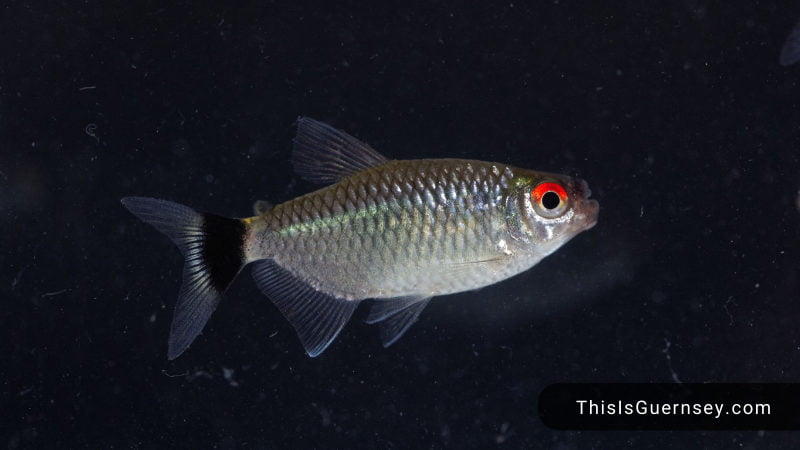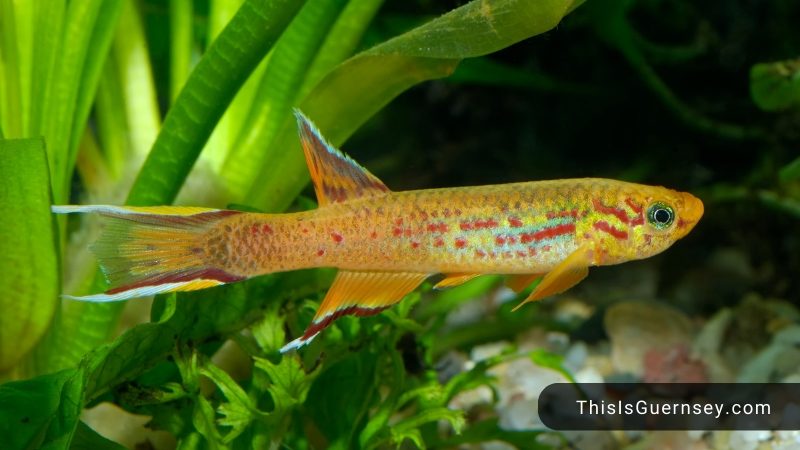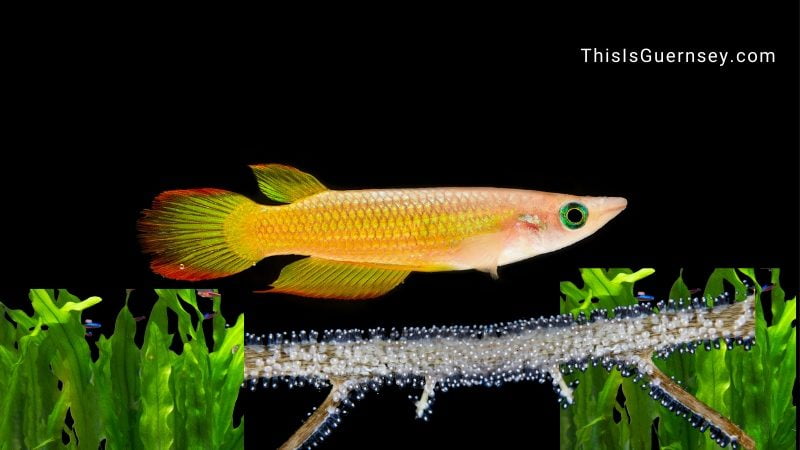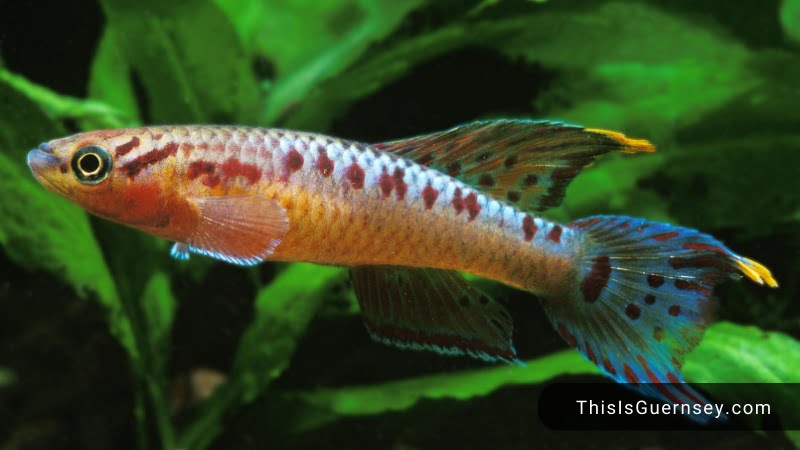Lampeye killifish breeding is one of the traits that an aquarist is usually very interested in. It is possible that the lampeye might be a wise choice for you if you are looking for a suitable tropical fish for your community tank. In addition to being quite unique in appearance and behavior, this tropical fish species will certainly add to the excitement in your aquarium.
General Lampeye Killifish Breeding Guide
In order to raise this peaceful fish, you need to follow some simple steps. For the spawning to take place, your tank does not have to be set up in a special way. In a couple of hours, you will see that the fry will spawn and you will see that the eggs will be laid when they are ready. There is the possibility that the small fish may be eaten by a fish in the same tank who is a carnivore if you have other carnivores in your tank.
Setting up a dedicated aquarium for breeding aquarium hardy fish is a very good idea. This can be easily done without a lot of trouble. The setup is much the same as the one used in the main tank. You could then move them back to the main aquarium once they have grown up to the size of adults.
Norman’s Lampeye Killifish
Norman’s Lampeye Killifish, also known as Poropanchax normani, are an egg-laying freshwater fish species that are relatively easy to breed in an aquarium setting. Norman’s Lampeye Killifish, you will need to provide them with a suitable spawning environment that mimics their natural habitat. This includes a planted aquarium with a substrate of fine gravel or sand, as well as plenty of hiding places in the form of live plants or driftwood.
When it comes, the males will typically perform a courtship display to attract the females, after which they will deposit their eggs on the bottom of the aquarium or on a surface, such as a plant leaf. Once the eggs have been laid, it is important to remove the adult fish from the tank, as they may eat the eggs.
Lampeye Tetra

Lampeye Tetras, also known as Moenkhausia sanctaefilomenae, are an easy to breed freshwater fish species that are a popular choice for many aquarium enthusiasts. To successfully breed Lampeye Tetras, you will need to provide them with the right conditions and environment.
To begin with, you should have a breeding pair of healthy adult Lampeye Tetras. These fish breed readily in an aquarium, but you should make sure that they have plenty of space to swim and move around. The tank size that is minimum tank size 10 gallons is recommended, with live plants or other decorations that provide hiding places for the fish.
Once the breeding pair has been established, the female will lay her eggs on a flat surface such as a plant leaf or on the bottom of the tank. It is important to remove the adult fish from the breeding tank once the eggs have been laid, as they may eat their own eggs or the fry.
Why We Should Choose Poropanchax Normani For Breeding?
Lampeyes make wonderful pets because they need very little care and they have a very long lifespan. Because of their ability to survive in different types of conditions, lampeyes make wonderful pets. You should set parameters to support the wellness of your employees so that they will thrive as long as you adhere to them.
Those who wish to build an environment that fosters harmony and peace are also attracted to this species. In comparison to the others in the tank, it is remarkably peaceful for both the bottom, middle, and top dwellers. Depending on the invertebrate’s tank mates, they can even get along with one another. Furthermore, there are fish buddies onboard your aquarium who can help you inseminate them. There is no such complicated process or procedure for the lampeye species. It is possible for aquarists at any level of experience to do it relatively easily.
Suitable for beginners as well as experts
The fish is an excellent option for beginners and experienced aquarists alike, since it is sensitive to human interference, and it is easy to take care of. In addition to the fact that it is a great tankmate for the community of plants in tanks, it is also low in maintenance.
There are a lot of advantages to having a lampeye added to your nano aquarium if you already own one. Because the fish are small size and can be kept in planted aquariums as well, it makes them a great choice for tanks.
If you turn on the aquarium light, it will appear as if the shades are shining under the intense light that the aquarium is emitting. You will truly feel glad that you decided to add this fish to your tank because you will be amazed at how it makes your tank look.
Inhabitants of the upper part

There is no doubt that Norman’s panchax killifish are the top-level dwellers in your tank. It is an observation that you will see if you look at your community aquarium, that most of the fish spend most of their time in the middle and upper portions of the aquarium.
Besides that, they are generally good jumpers as well. You need to make sure that the lid of the tank is a tight-fitting one in order to ensure they do not escape from the aquarium. Some people elect not to install a canopy over their aquarium in order to avoid affecting the lighting. It is possible to use the lower water level instead of the lid if you think the lid could disrupt the lighting.
In addition, it is important to ensure that each group of fish has its own space to move around in. If you don’t want your fish to suffer from distress, try not to overcrowd your tank. The floating plants make for a good natural cover which will really make your Panchax killifish buddies very happy. This means that heavy plants in the tank can bring lots of benefits to these little pets, which is why it is such a good idea.
How Lampeye Behaves?
The panchax fish are shoaling species that are very entertaining to watch. The fact that they are so small means that you can add them to nano, micro, and small aquariums that have such a small size. As long as they have space to swim, they will thrive so very long as they have an adequate amount of space to do their activities. They are partial to hiding in shade or remaining in the darkness.
For that reason, getting them into tank with high levels of vegetation is a good idea. If you want you can also look at examples of nano-tanks that are shared on the internet by other owners where you can take a look at them. This peaceful and small community tank is home to a number of panchax fish that have become befriended by many residents of the nano tanks.
Species of poeciliidae
Poeciliidae is the family that the lampeye belongs to. Despite the fact that the lampeyes look like guppies and mollies, they belong to the Lampeye Family. Although they lay their eggs differently, they are not the same as the mollies and guppies. The closest relatives of this fish to this species are called the killifish because of their similarity to this fish.
Many species of fish exist with different families that have similar taxa, but they have also been classified as killifish, but that is not always the case.
In the end, it turned out that the lampeye panchax in the picture was another species of fish.
How do lampeye killifish eggs look like?

Lampeye Killifish eggs are very small and difficult to see with the naked eye. They are usually clear or whitish in color and are laid in a single layer on a flat surface, such as the leaves of plants or the bottom of the tank. The eggs are sticky and can adhere to the surface on which they are laid. Lampeye Killifish females can lay hundreds of eggs at one time, which will hatch within a few days, depending on water temperature and other environmental factors.
How To Take Care Of Lampeyes And Their Aquarium?
Maintaining the water conditions and the tank environment in which your fish can live in an environment that resembles the conditions of their natural environment is the best way of taking care of them.
Aquifer conditions
Before you start to fill your tank, make sure that your tank has been prepared properly, especially water quality.
Panchax fish are highly sensitive to changes in water supply and other conditions of the environment. Ammonia and nitrites, which are found in the water, should be removed as soon as possible. It is a good idea to let your aquarium mature before you introduce your lampeye fish to it so that you would be able to give it a nice home.
In order to make sure that your fish are always healthy and well, you must also make sure that the water in your heavily planted tank is of good quality.
Make sure to stick to these variables in order to maintain the quality of the water:
- Keep the pH between 6.0 and 7.5.
- The hardness should be between 18 and 215 parts per million.
- The temperature should range between 24 and 28 Celsius.
The decorations
There must be a lot of vegetation and dense plants as well as slow water movements for the shoaling fish to thrive. This aquarium characteristic is one of the best for replicating the natural habitat of a specific fish species. The size of the fish means that they tend to be shy and afraid when they face bigger creatures within or outside of the tank since they are small in comparison.
Therefore, vegetation is needed by them as a source of shade and cover, to provide them with a place to hide and relax. There are several textures and shapes that are very similar to your panchax, tiny fish habitats such as streams, brooks, and small rivers, which are planted heavily in the tank. Some people feel that hardy fish simply because they are easy to care for. However, others may disagree with this statement.
As a bonus, you can also stick some tall plants into the driftwood if you want to go the extra mile. It is recommended that you utilize a dark substrate as a part of the bottom part of your build.
As a result of the dark-colored sand, the fish can glow in the middle of the night especially during the night as the contrast between the dark and the pale sand enhances their brightness.
This buddy has a beautiful colouration of blue, which makes it easy to see its most notable feature.
Lights
It is vital that the lights in the tank are dimmed in order to create a cool and relaxing atmosphere for the fish. The bright lights of the tank may intimidate them and they will start acting aggressively.
In addition to providing shade and making the light dim, the floating plants and dense vegetation can protect us from the sun.
How Feeding Lampeyes
The lampeye tiny buddies are not so picky when it comes to food. They will take everything you add to their tank and they will be glad for it. The expert recommends tropical fish flake. But you can mix the diets with live or frozen foods as routine treats, like brine shrimp, cyclops, mini bloodworms, mosquito larvae, and so on.
Even so, they will need healthy variations in their diets. Focus only on high-quality foods to keep them healthy and well.
FAQs
Are lampeye killifish capable of laying eggs?
During the egg-laying process, they produce eggs that are attached to the plants. Using spawning mops in a tank will serve the same purpose as the use of spawning mops. Breeding tanks and species tanks are both a possible setup for these fish to spawn.
What are lampeye tank mates?
Lampeye fish are typically small, and, as a result, you might think about pairing them with other peaceful little fish like shrimp, tetras, and corydoras. Fish will not be able to fight by himself. So, if you want to track this down, you could add a group of at least 10 opportunistic lampeyes. These fish like to have a good time doing everything in a group.
What is the life expectancy of lampeye fish?
In perfect conditions, they are capable of living up to three years.
References:
- Poropanchax normani – https://en.wikipedia.org/wiki/Poropanchax_normani
- Killifish – https://www.nationalgeographic.com/animals/article/pollution-tolerant-killifish-discovered-east-coast-waters

Annette M. Chaney is an experienced marine biologist with over 20 years of experience as an aquarist and fishkeeper. She started her first aquarium at a young age, filling it with frogs and goldfish obtained from the ten-cent pet store.
Annette grew up caring for and breeding African Cichlids, which led to a hobby in high school that doubled as a profitable means. Attending Reed College gave her time to solidify herself as an accomplished aquarium caretaker with an eye for sales. After that, from 2009 – 2013, she studied at Roger Williams University – one of the most prestigious universities for Aquaculture and Aquarium in USA. She is the founder of AquariumCircle since 2010.
